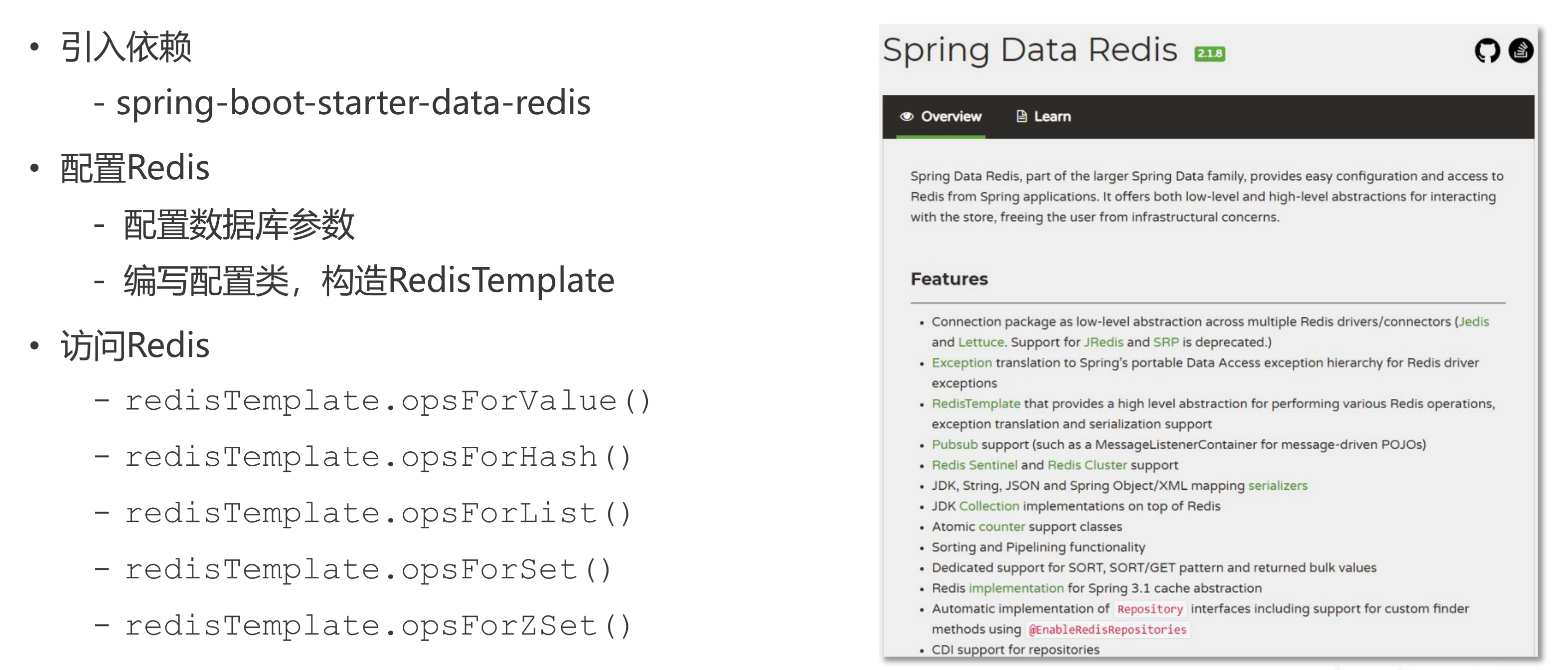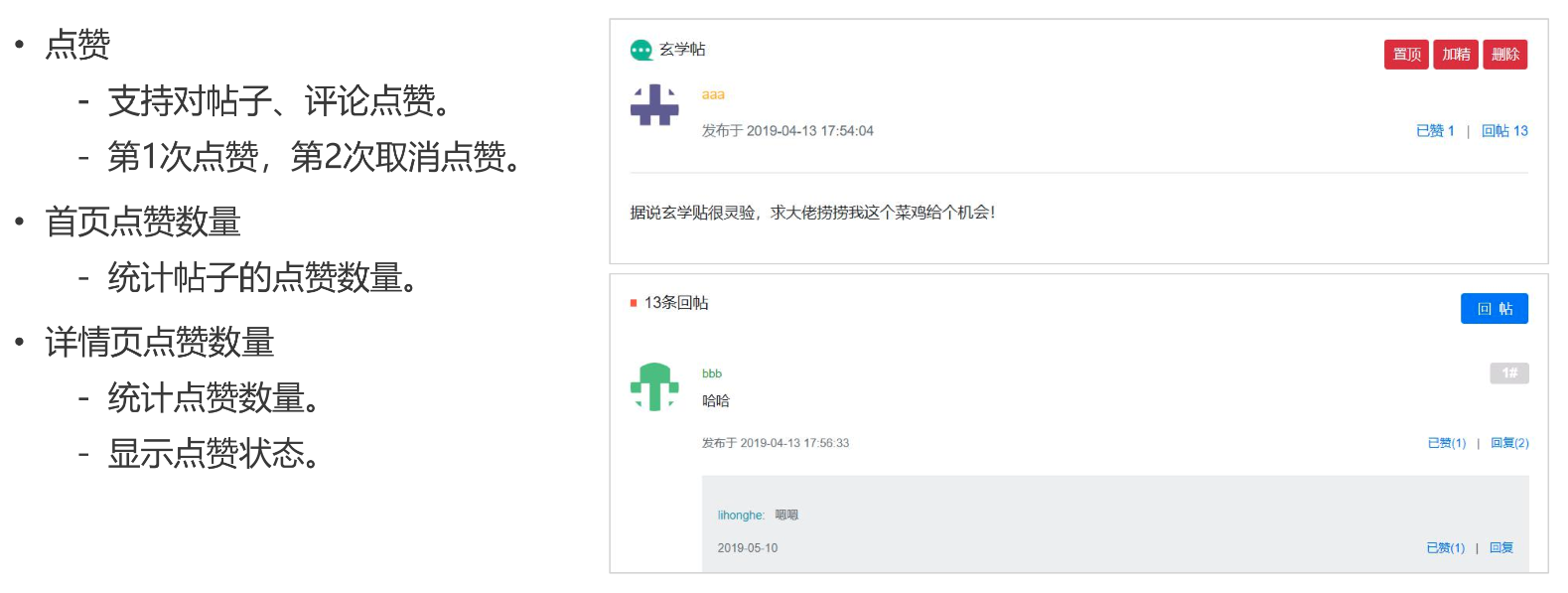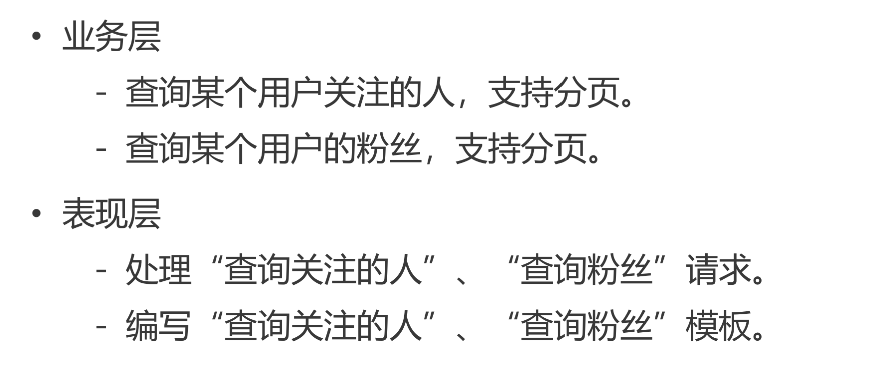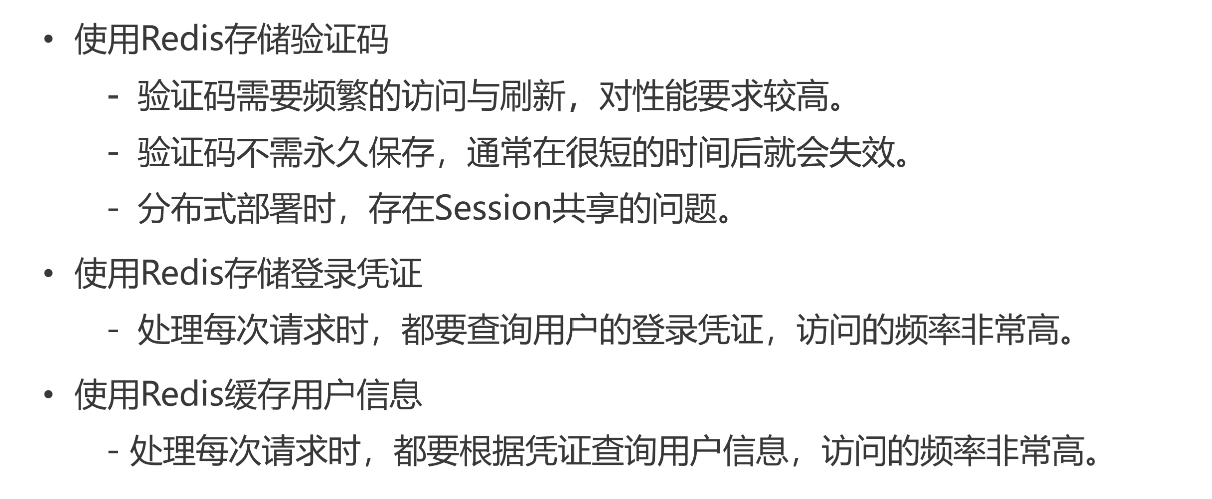第三章 高性能存储方案
Spring 整合 Redis

引入依赖
<dependency>
<groupId>org.springframework.boot</groupId>
<artifactId>spring-boot-starter-data-redis</artifactId>
</dependency>
Redis 相关配置类
@Configuration
public class RedisConfig {
@Bean
public RedisTemplate<String, Object> redisTemplate(RedisConnectionFactory factory) {
RedisTemplate<String, Object> template = new RedisTemplate<>();
template.setConnectionFactory(factory);
template.setKeySerializer(RedisSerializer.string());
template.setValueSerializer(RedisSerializer.json());
template.setHashKeySerializer(RedisSerializer.string());
template.setHashValueSerializer(RedisSerializer.json());
template.afterPropertiesSet();
return template;
}
}
测试
@SpringBootTest
@ContextConfiguration(classes = CommunityApplication.class)
public class RedisTests {
@Autowired
private RedisTemplate redisTemplate;
@Test
public void testStrings() {
String redisKey = "test:count";
redisTemplate.opsForValue().set(redisKey, 1);
System.out.println(redisTemplate.opsForValue().get(redisKey));
System.out.println(redisTemplate.opsForValue().increment(redisKey));
System.out.println(redisTemplate.opsForValue().decrement(redisKey));
}
@Test
public void testHashes() {
String redisKey = "test:user";
redisTemplate.opsForHash().put(redisKey, "id", 1);
redisTemplate.opsForHash().put(redisKey, "username", "zhangsan");
System.out.println(redisTemplate.opsForHash().get(redisKey, "id"));
System.out.println(redisTemplate.opsForHash().get(redisKey, "username"));
}
@Test
public void testLists() {
String redisKey = "test:ids";
redisTemplate.opsForList().leftPush(redisKey, 101);
redisTemplate.opsForList().leftPush(redisKey, 102);
redisTemplate.opsForList().leftPush(redisKey, 103);
System.out.println(redisTemplate.opsForList().size(redisKey));
System.out.println(redisTemplate.opsForList().index(redisKey, 0));
System.out.println(redisTemplate.opsForList().range(redisKey, 0, 2));
System.out.println(redisTemplate.opsForList().leftPop(redisKey));
System.out.println(redisTemplate.opsForList().leftPop(redisKey));
System.out.println(redisTemplate.opsForList().leftPop(redisKey));
}
@Test
public void testSets() {
String redisKey = "test:teachers";
redisTemplate.opsForSet().add(redisKey, "刘备", "关羽", "张飞", "赵云", "诸葛亮");
System.out.println(redisTemplate.opsForSet().size(redisKey));
System.out.println(redisTemplate.opsForSet().pop(redisKey));
System.out.println(redisTemplate.opsForSet().members(redisKey));
}
@Test
public void testSortedSets() {
String redisKey = "test:students";
redisTemplate.opsForZSet().add(redisKey, "唐僧", 80);
redisTemplate.opsForZSet().add(redisKey, "悟空", 90);
redisTemplate.opsForZSet().add(redisKey, "八戒", 50);
redisTemplate.opsForZSet().add(redisKey, "沙僧", 70);
redisTemplate.opsForZSet().add(redisKey, "白龙马", 60);
System.out.println(redisTemplate.opsForZSet().zCard(redisKey));
System.out.println(redisTemplate.opsForZSet().score(redisKey, "八戒"));
System.out.println(redisTemplate.opsForZSet().reverseRank(redisKey, "八戒"));
System.out.println(redisTemplate.opsForZSet().reverseRange(redisKey, 0, 2));
}
@Test
public void testKeys() {
redisTemplate.delete("test:user");
System.out.println(redisTemplate.hasKey("test:user"));
redisTemplate.expire("test:students", 10, TimeUnit.SECONDS);
}
@Test
public void testBoundOperations() {
String redisKey = "test:count";
BoundValueOperations operations = redisTemplate.boundValueOps(redisKey);
operations.increment();
operations.increment();
operations.increment();
operations.increment();
operations.increment();
System.out.println(operations.get());
}
@Test
public void testTransactional() {
Object obj = redisTemplate.execute(new SessionCallback() {
@Override
public Object execute(RedisOperations operations) throws DataAccessException {
String redisKey = "test:tx";
operations.multi();
operations.opsForSet().add(redisKey, "zhangsan");
operations.opsForSet().add(redisKey, "lisi");
operations.opsForSet().add(redisKey, "wangwu");
System.out.println(operations.opsForSet().members(redisKey));
return operations.exec();
}
});
System.out.println(obj);
}
}
整合点赞功能

工具类
public class RedisKeyUtil {
private static final String SPLIT = ":";
private static final String PREFIX_ENTITY_LIKE = "like:entity";
public static String getEntityLikeKey(int entityType, int entityId) {
return PREFIX_ENTITY_LIKE + SPLIT + entityType + SPLIT + entityId;
}
}
业务层
@Service
public class LikeService {
@Autowired
private RedisTemplate redisTemplate;
public void like(int userId, int entityType, int entityId) {
String entityLikeKey = RedisKeyUtil.getEntityLikeKey(entityType, entityId);
Boolean isMember = redisTemplate.opsForSet().isMember(entityLikeKey, userId);
if (isMember) {
redisTemplate.opsForSet().remove(entityLikeKey, userId);
} else {
redisTemplate.opsForSet().add(entityLikeKey, userId);
}
}
public long findEntityLikeCount(int entityType, int entityId) {
String entityLikeKey = RedisKeyUtil.getEntityLikeKey(entityType, entityId);
return redisTemplate.opsForSet().size(entityLikeKey);
}
public int findEntityLikeStatus(int userId, int entityType, int entityId) {
String entityLikeKey = RedisKeyUtil.getEntityLikeKey(entityType, entityId);
return redisTemplate.opsForSet().isMember(entityLikeKey, userId) ? 1 : 0;
}
}
控制层
@RequestMapping(path = "/index", method = RequestMethod.GET)
public String getIndexPage(Model model, Page page) {
page.setRows(discussPostService.findDiscussPostRows(0));
page.setPath("/index");
List<DiscussPost> list = discussPostService.findDiscussPosts(0, page.getOffset(), page.getLimit());
List<Map<String, Object>> discussPosts = new ArrayList<>();
if (list != null) {
for (DiscussPost post : list) {
Map<String, Object> map = new HashMap<>();
map.put("post", post);
User user = userService.findUserById(post.getUserId());
map.put("user", user);
long likeCount = likeService.findEntityLikeCount(ENTITY_TYPE_POST, post.getId());
map.put("likeCount", likeCount);
discussPosts.add(map);
}
}
model.addAttribute("discussPosts", discussPosts);
return "/index";
}
@Controller
public class LikeController {
@Autowired
private LikeService likeService;
@Autowired
private HostHolder hostHolder;
@RequestMapping(path = "/like", method = RequestMethod.POST)
@ResponseBody
public String like(int entityType, int entityId) {
User user = hostHolder.getUser();
likeService.like(user.getId(), entityType, entityId);
long likeCount = likeService.findEntityLikeCount(entityType, entityId);
int likeStatus = likeService.findEntityLikeStatus(user.getId(), entityType, entityId);
HashMap<String, Object> map = new HashMap<>();
map.put("likeCount", likeCount);
map.put("likeStatus", likeStatus);
return CommunityUtil.getJSONString(0, null, map);
}
}
- DiscussPostController.java
@RequestMapping(path = "/detail/{discussPostId}", method = RequestMethod.GET)
public String getDiscussPost(@PathVariable("discussPostId") int discussPostId, Model model, Page page) {
DiscussPost post = discussPostService.findDiscusspostById(discussPostId);
model.addAttribute("post", post);
User user = userService.findUserById(post.getUserId());
model.addAttribute("user", user);
long likeCount = likeService.findEntityLikeCount(ENTITY_TYPE_POST, discussPostId);
model.addAttribute("likeCount", likeCount);
int likeStatus = hostHolder.getUser() == null ? 0 : likeService.findEntityLikeStatus(hostHolder.getUser().getId(), ENTITY_TYPE_POST, discussPostId);
model.addAttribute("likeStatus", likeStatus);
page.setLimit(5);
page.setPath("/discuss/detail/" + discussPostId);
page.setRows(post.getCommentCount());
List<Comment> commentList = commentService.findCommentsByEntity(ENTITY_TYPE_POST, post.getId(), page.getOffset(), page.getLimit());
List<Map<String, Object>> commentVoList = new ArrayList<>();
if (commentList != null) {
for (Comment comment : commentList) {
Map<String, Object> commentVo = new HashMap<>();
commentVo.put("comment", comment);
commentVo.put("user", userService.findUserById(comment.getUserId()));
likeCount = likeService.findEntityLikeCount(ENTITY_TYPE_COMMENT, comment.getId());
commentVo.put("likeCount", likeCount);
likeStatus = hostHolder.getUser() == null ? 0 : likeService.findEntityLikeStatus(hostHolder.getUser().getId(), ENTITY_TYPE_COMMENT, comment.getId());
commentVo.put("likeStatus", likeStatus);
List<Comment> replyList = commentService.findCommentsByEntity(ENTITY_TYPE_COMMENT, comment.getId(), 0, Integer.MAX_VALUE);
List<Map<String, Object>> replyVoList = new ArrayList<>();
if (replyList != null) {
for (Comment reply : replyList) {
Map<String, Object> replyVo = new HashMap<>();
replyVo.put("reply", reply);
replyVo.put("user", userService.findUserById(reply.getUserId()));
User target = reply.getTargetId() == 0 ? null : userService.findUserById(reply.getTargetId());
replyVo.put("target", target);
likeCount = likeService.findEntityLikeCount(ENTITY_TYPE_COMMENT, reply.getId());
replyVo.put("likeCount", likeCount);
likeStatus = hostHolder.getUser() == null ? 0 : likeService.findEntityLikeStatus(hostHolder.getUser().getId(), ENTITY_TYPE_COMMENT, reply.getId());
replyVo.put("likeStatus", likeStatus);
replyVoList.add(replyVo);
}
}
commentVo.put("replys", replyVoList);
int replyCount = commentService.findCommentCount(ENTITY_TYPE_COMMENT, comment.getId());
commentVo.put("replyCount", replyCount);
commentVoList.add(commentVo);
}
}
model.addAttribute("comments", commentVoList);
return "/site/discuss-detail";
}
重构点赞功能及开发个人主页

工具类
public class RedisKeyUtil {
private static final String SPLIT = ":";
private static final String PREFIX_ENTITY_LIKE = "like:entity";
private static final String PREFIX_USER_LIKE = "like:user";
public static String getEntityLikeKey(int entityType, int entityId) {
return PREFIX_ENTITY_LIKE + SPLIT + entityType + SPLIT + entityId;
}
public static String getUserLikeKey(int userId) {
return PREFIX_USER_LIKE + SPLIT + userId;
}
}
业务层
@Service
public class LikeService {
@Autowired
private RedisTemplate redisTemplate;
public void like(int userId, int entityType, int entityId, int entityUserId) {
redisTemplate.execute(new SessionCallback() {
@Override
public Object execute(RedisOperations operations) throws DataAccessException {
String entityLikeKey = RedisKeyUtil.getEntityLikeKey(entityType, entityId);
String userLikeKey = RedisKeyUtil.getUserLikeKey(entityUserId);
boolean isMember = operations.opsForSet().isMember(entityLikeKey, userId);
operations.multi();
if (isMember) {
operations.opsForSet().remove(entityLikeKey, userId);
operations.opsForValue().decrement(userLikeKey);
} else {
operations.opsForSet().add(entityLikeKey, userId);
operations.opsForValue().increment(userLikeKey);
}
return operations.exec();
}
});
}
public long findEntityLikeCount(int entityType, int entityId) {
String entityLikeKey = RedisKeyUtil.getEntityLikeKey(entityType, entityId);
return redisTemplate.opsForSet().size(entityLikeKey);
}
public int findEntityLikeStatus(int userId, int entityType, int entityId) {
String entityLikeKey = RedisKeyUtil.getEntityLikeKey(entityType, entityId);
return redisTemplate.opsForSet().isMember(entityLikeKey, userId) ? 1 : 0;
}
public int findUserLikeCount(int userId) {
String userLikeKey = RedisKeyUtil.getUserLikeKey(userId);
Integer count = (Integer) redisTemplate.opsForValue().get(userLikeKey);
return count == null ? 0 : count.intValue();
}
}
控制层
@Controller
public class LikeController {
@Autowired
private LikeService likeService;
@Autowired
private HostHolder hostHolder;
@RequestMapping(path = "/like", method = RequestMethod.POST)
@ResponseBody
public String like(int entityType, int entityId, int entityUserId) {
User user = hostHolder.getUser();
likeService.like(user.getId(), entityType, entityId, entityUserId);
long likeCount = likeService.findEntityLikeCount(entityType, entityId);
int likeStatus = likeService.findEntityLikeStatus(user.getId(), entityType, entityId);
HashMap<String, Object> map = new HashMap<>();
map.put("likeCount", likeCount);
map.put("likeStatus", likeStatus);
return CommunityUtil.getJSONString(0, null, map);
}
}
@RequestMapping(path = "/profile/{userId}", method = RequestMethod.GET)
public String getProfilePage(@PathVariable("userId") int userId, Model model) {
User user = userService.findUserById(userId);
if (user == null) {
throw new RuntimeException("该用户不存在!");
}
model.addAttribute("user", user);
int likeCount = likeService.findUserLikeCount(userId);
model.addAttribute("likeCount", likeCount);
return "/site/profile";
}
整合关注功能

工具类
public class RedisKeyUtil {
private static final String SPLIT = ":";
private static final String PREFIX_FOLLOWEE = "followee";
private static final String PREFIX_FOLLOWER = "follower";
public static String getFolloweeKey(int userId, int entityType) {
return PREFIX_FOLLOWEE + SPLIT + userId + SPLIT + entityType;
}
public static String getFollowerKey(int entityType, int entityId) {
return PREFIX_FOLLOWER + SPLIT + entityType + SPLIT + entityId;
}
}
public interface CommunityConstant {
int ENTITY_TYPE_POST = 1;
int ENTITY_TYPE_COMMENT = 2;
int ENTITY_TYPE_USER = 3;
}
业务层
@Service
public class FollowService {
@Autowired
private RedisTemplate redisTemplate;
public void follow(int userId, int entityType, int entityId) {
redisTemplate.execute(new SessionCallback() {
@Override
public Object execute(RedisOperations operations) throws DataAccessException {
String followeeKey = RedisKeyUtil.getFolloweeKey(userId, entityType);
String followerKey = RedisKeyUtil.getFollowerKey(entityType, entityId);
operations.multi();
operations.opsForZSet().add(followeeKey, entityId, System.currentTimeMillis());
operations.opsForZSet().add(followerKey, userId, System.currentTimeMillis());
return operations.exec();
}
});
}
public void unfollow(int userId, int entityType, int entityId) {
redisTemplate.execute(new SessionCallback() {
@Override
public Object execute(RedisOperations operations) throws DataAccessException {
String followeeKey = RedisKeyUtil.getFolloweeKey(userId, entityType);
String followerKey = RedisKeyUtil.getFollowerKey(entityType, entityId);
operations.multi();
operations.opsForZSet().remove(followeeKey, entityId);
operations.opsForZSet().remove(followerKey, userId);
return operations.exec();
}
});
}
public long findFolloweeCount(int userId, int entityType) {
String followeeKey = RedisKeyUtil.getFolloweeKey(userId, entityType);
return redisTemplate.opsForZSet().zCard(followeeKey);
}
public long findFollowerCount(int entityType, int entityId) {
String followerKey = RedisKeyUtil.getFollowerKey(entityType, entityId);
return redisTemplate.opsForZSet().zCard(followerKey);
}
public boolean hasFollowed(int userId, int entityType, int entityId) {
String followeeKey = RedisKeyUtil.getFolloweeKey(userId, entityType);
return redisTemplate.opsForZSet().score(followeeKey, entityId) != null;
}
}
控制层
@Controller
public class FollowController {
@Autowired
private FollowService followService;
@Autowired
private HostHolder hostHolder;
@RequestMapping(path = "/follow", method = RequestMethod.POST)
@ResponseBody
public String follow(int entityType, int entityId) {
User user = hostHolder.getUser();
followService.follow(user.getId(), entityType, entityId);
return CommunityUtil.getJSONString(0, "已关注!");
}
@RequestMapping(path = "/unfollow", method = RequestMethod.POST)
@ResponseBody
public String unfollow(int entityType, int entityId) {
User user = hostHolder.getUser();
followService.unfollow(user.getId(), entityType, entityId);
return CommunityUtil.getJSONString(0, "已取消关注!");
}
}
@RequestMapping(path = "/profile/{userId}", method = RequestMethod.GET)
public String getProfilePage(@PathVariable("userId") int userId, Model model) {
User user = userService.findUserById(userId);
if (user == null) {
throw new RuntimeException("该用户不存在!");
}
model.addAttribute("user", user);
int likeCount = likeService.findUserLikeCount(userId);
model.addAttribute("likeCount", likeCount);
long followeeCount = followService.findFolloweeCount(userId, ENTITY_TYPE_USER);
model.addAttribute("followeeCount", followeeCount);
long followerCount = followService.findFollowerCount(ENTITY_TYPE_USER, userId);
model.addAttribute("followerCount", followerCount);
boolean hasFollowed = false;
if (hostHolder.getUser() != null) {
hasFollowed = followService.hasFollowed(hostHolder.getUser().getId(), ENTITY_TYPE_USER, userId);
}
model.addAttribute("hasFollowed", hasFollowed);
return "/site/profile";
}
关注列表、粉丝列表

业务层
public List<Map<String, Object>> findFollowees(int userId, int offset, int limit) {
String followeeKey = RedisKeyUtil.getFolloweeKey(userId, ENTITY_TYPE_USER);
Set<Integer> targetIds = redisTemplate.opsForZSet().reverseRange(followeeKey, offset, offset + limit - 1);
if (targetIds == null) {
return null;
}
List<Map<String, Object>> list = new ArrayList<>();
for (Integer targetId : targetIds) {
Map<String, Object> map = new HashMap<>();
User user = userService.findUserById(targetId);
map.put("user", user);
Double score = redisTemplate.opsForZSet().score(followeeKey, targetId);
map.put("followTime", new Date(score.longValue()));
list.add(map);
}
return list;
}
public List<Map<String, Object>> findFollowers(int userId, int offset, int limit) {
String followerKey = RedisKeyUtil.getFollowerKey(ENTITY_TYPE_USER, userId);
Set<Integer> targetIds = redisTemplate.opsForZSet().reverseRange(followerKey, offset, offset + limit - 1);
if (targetIds == null) {
return null;
}
List<Map<String, Object>> list = new ArrayList<>();
for (Integer targetId : targetIds) {
Map<String, Object> map = new HashMap<>();
User user = userService.findUserById(targetId);
map.put("user", user);
Double score = redisTemplate.opsForZSet().score(followerKey, targetId);
map.put("followTime", new Date(score.longValue()));
list.add(map);
}
return list;
}
控制层
@RequestMapping(path = "/followees/{userId}", method = RequestMethod.GET)
public String getFollowees(@PathVariable("userId") int userId, Page page, Model model) {
User user = userService.findUserById(userId);
if (user == null) {
throw new RuntimeException("该用户不存在!");
}
model.addAttribute("user", user);
page.setLimit(5);
page.setPath("/followees/" + userId);
page.setRows((int) followService.findFolloweeCount(userId, ENTITY_TYPE_USER));
List<Map<String, Object>> userList = followService.findFollowees(userId, page.getOffset(), page.getLimit());
if (userList != null) {
for (Map<String, Object> map : userList) {
User u = (User) map.get("user");
map.put("hasFollowed", hasFollowed(u.getId()));
}
}
model.addAttribute("users", userList);
return "/site/followee";
}
private boolean hasFollowed(int userId) {
if (hostHolder.getUser() == null) {
return false;
}
return followService.hasFollowed(hostHolder.getUser().getId(), ENTITY_TYPE_USER, userId);
}
@RequestMapping(path = "/followers/{userId}", method = RequestMethod.GET)
public String getFollowers(@PathVariable("userId") int userId, Page page, Model model) {
User user = userService.findUserById(userId);
if (user == null) {
throw new RuntimeException("该用户不存在!");
}
model.addAttribute("user", user);
page.setLimit(5);
page.setPath("/followers/" + userId);
page.setRows((int) followService.findFollowerCount(ENTITY_TYPE_USER, userId));
List<Map<String, Object>> userList = followService.findFollowers(userId, page.getOffset(), page.getLimit());
if (userList != null) {
for (Map<String, Object> map : userList) {
User u = (User) map.get("user");
map.put("hasFollowed", hasFollowed(u.getId()));
}
}
model.addAttribute("users", userList);
return "/site/follower";
}
优化登录模块

使用 Redis 存储验证码
工具类
public class RedisKeyUtil {
private static final String PREFIX_KAPTCHA = "kaptcha";
public static String getKaptchaKey(String owner) {
return PREFIX_KAPTCHA + SPLIT + owner;
}
}
控制层
@RequestMapping(path = "/kaptcha", method = RequestMethod.GET)
public void getKaptcha(HttpServletResponse response ) {
String text = kaptchaProducer.createText();
BufferedImage image = kaptchaProducer.createImage(text);
String kaptchaOwner = CommunityUtil.generateUUID();
Cookie cookie = new Cookie("kaptchaOwner", kaptchaOwner);
cookie.setMaxAge(60);
cookie.setPath(contextPath);
response.addCookie(cookie);
String redKey = RedisKeyUtil.getKaptchaKey(kaptchaOwner);
redisTemplate.opsForValue().set(redKey, text, 60, TimeUnit.SECONDS);
response.setContentType("image/png");
try {
OutputStream os = response.getOutputStream();
ImageIO.write(image, "png", os);
} catch (IOException e) {
logger.error("响应验证码失败:" + e.getMessage());
}
}
@RequestMapping(path = "/login", method = RequestMethod.POST)
public String login(String username, String password, String code, boolean rememberme, Model model, HttpServletResponse response, @CookieValue("kaptchaOwner") String kaptchaOwner) {
String kaptcha = null;
if (StringUtils.isNoneBlank(kaptchaOwner)) {
String redisKey = RedisKeyUtil.getKaptchaKey(kaptchaOwner);
kaptcha = (String) redisTemplate.opsForValue().get(redisKey);
}
if (StringUtils.isBlank(kaptcha) || StringUtils.isBlank(code) || !kaptcha.equalsIgnoreCase(code)) {
model.addAttribute("codeMsg", "验证码不正确!");
return "/site/login";
}
int expiredSeconds = rememberme ? REMEMBER_EXPIRED_SECONDS : DEFAULT_EXPIRED_SECONDS;
Map<String, Object> map = userService.login(username, password, expiredSeconds);
if (map.containsKey("ticket")) {
Cookie cookie = new Cookie("ticket", map.get("ticket").toString());
cookie.setPath(contextPath);
cookie.setMaxAge(expiredSeconds);
response.addCookie(cookie);
return "redirect:/index";
} else {
model.addAttribute("usernameMsg", map.get("usernameMsg"));
model.addAttribute("passwordMsg", map.get("passwordMsg"));
return "/site/login";
}
}
使用 Redis 存储登录凭证
工具类
public class RedisKeyUtil {
private static final String PREFIX_TICKET = "ticket";
public static String getTicketKey(String ticket) {
return PREFIX_TICKET + SPLIT + ticket;
}
}
数据层
public Map<String, Object> login(String username, String password, int expiredSeconds) {
Map<String, Object> map = new HashMap<>();
if (StringUtils.isBlank(username)) {
map.put("usernameMsg", "账号不能为空!");
return map;
}
if (StringUtils.isBlank(password)) {
map.put("passwordMsg", "密码不能为空!");
return map;
}
User user = userMapper.selectByName(username);
if (user == null) {
map.put("usernameMsg", "该账号不存在!");
return map;
}
if (user.getStatus() == 0) {
map.put("usernameMsg", "该账号未激活!");
return map;
}
password = CommunityUtil.md5(password + user.getSalt());
if (!user.getPassword().equals(password)) {
map.put("passwordMsg", "密码不正确!");
return map;
}
LoginTicket loginTicket = new LoginTicket();
loginTicket.setUserId(user.getId());
loginTicket.setTicket(CommunityUtil.generateUUID());
loginTicket.setStatus(0);
loginTicket.setExpired(new Date(System.currentTimeMillis() + expiredSeconds * 1000));
String redisKey = RedisKeyUtil.getTicketKey(loginTicket.getTicket());
redisTemplate.opsForValue().set(redisKey, loginTicket);
map.put("ticket", loginTicket.getTicket());
return map;
}
public void loginOut(String ticket) {
String redisKey = RedisKeyUtil.getTicketKey(ticket);
LoginTicket loginTicket = (LoginTicket) redisTemplate.opsForValue().get(redisKey);
loginTicket.setStatus(1);
redisTemplate.opsForValue().set(redisKey, loginTicket);
}
public LoginTicket findLoginTicket(String ticket) {
String redisKey = RedisKeyUtil.getTicketKey(ticket);
return (LoginTicket) redisTemplate.opsForValue().get(redisKey);
}
使用 Redis 缓存用户信息
工具类
public class RedisKeyUtil {
private static final String PREFIX_USER = "user";
public static String getUserKey(int userId) {
return PREFIX_USER + SPLIT + userId;
}
}
业务层
public User findUserById(int id) {
User user = getCache(id);
if (user == null) {
user = initCache(id);
}
return user;
}
public int activation(int userId, String code) {
User user = userMapper.selectById(userId);
if (user.getStatus() == 1) {
return ACTIVATION_REPEAT;
} else if (user.getActivationCode().equals(code)) {
userMapper.updateStatus(userId, 1);
clearCache(userId);
return ACTIVATION_SUCCESS;
} else {
return ACTIVATION_FAILURE;
}
}
public int updateHeader(int userId, String headerUrl) {
int rows = userMapper.updateHeader(userId, headerUrl);
clearCache(userId);
return rows;
}
public boolean updatePassword(int userId, String oldPassword, String newPassword) {
User user = userMapper.selectById(userId);
String salt = user.getSalt();
if (CommunityUtil.md5(oldPassword + salt).equals(user.getPassword())) {
newPassword = CommunityUtil.md5(newPassword + salt);
userMapper.updatePassword(userId, newPassword);
clearCache(userId);
return true;
}
return false;
}
private User getCache(int userId) {
String redisKey = RedisKeyUtil.getUserKey(userId);
return (User) redisTemplate.opsForValue().get(redisKey);
}
private User initCache(int userId) {
User user = userMapper.selectById(userId);
String redisKey = RedisKeyUtil.getUserKey(userId);
redisTemplate.opsForValue().set(redisKey, user, 3600, TimeUnit.SECONDS);
return user;
}
private void clearCache(int userId) {
String redisKey = RedisKeyUtil.getUserKey(userId);
redisTemplate.delete(redisKey);
}




























 109
109











 被折叠的 条评论
为什么被折叠?
被折叠的 条评论
为什么被折叠?










